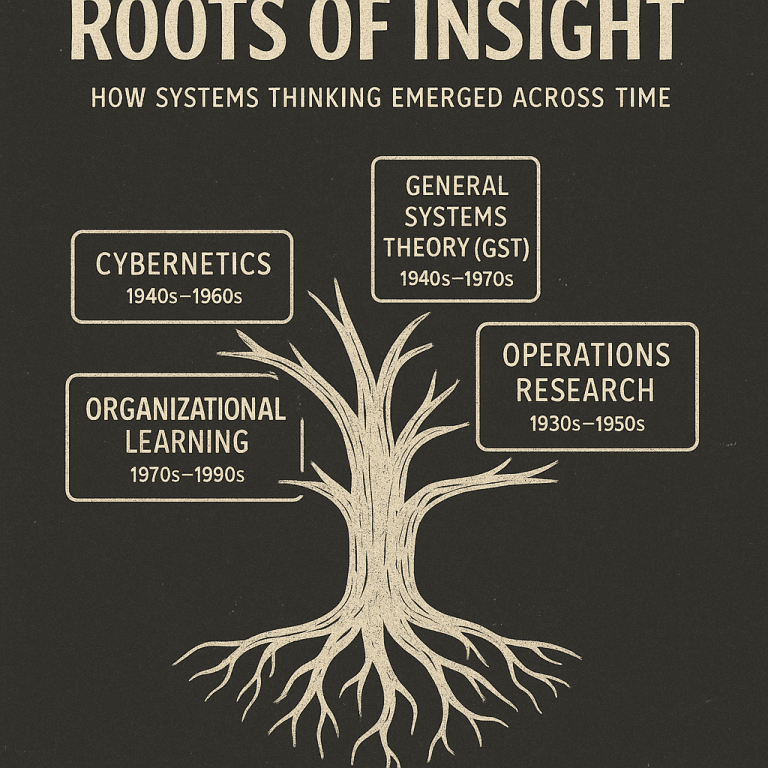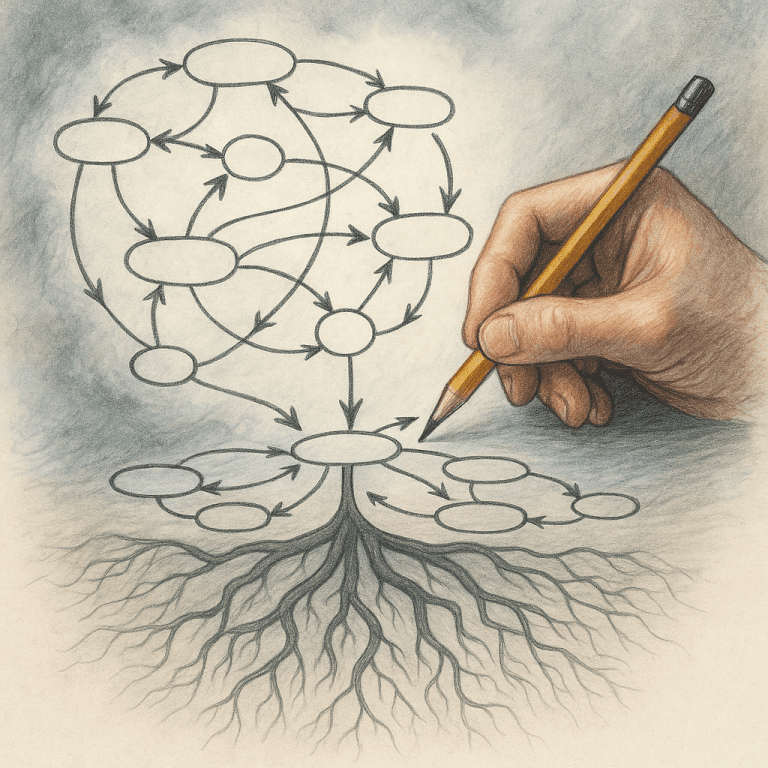Introduction
As we step deeper into the 21st century, one truth is becoming increasingly clear: traditional institutions—especially in the public sector—are not keeping pace with the complex, fast-evolving problems they were designed to manage. From climate crises to digital disruption, institutions everywhere are facing a world that defies prediction and demands adaptation.
Understanding the VUCA World
To navigate this evolving landscape, institutions must first understand the nature of the environment they operate in. Strategic thinkers often describe today’s context as a VUCA world:
- Volatile – Conditions change rapidly and unexpectedly
- Uncertain – Outcomes are unclear, and past experiences offer limited guidance
- Complex – Many interdependent variables interact in dynamic, often nonlinear ways
- Ambiguous – Situations lack clear meaning, with no obvious right answers
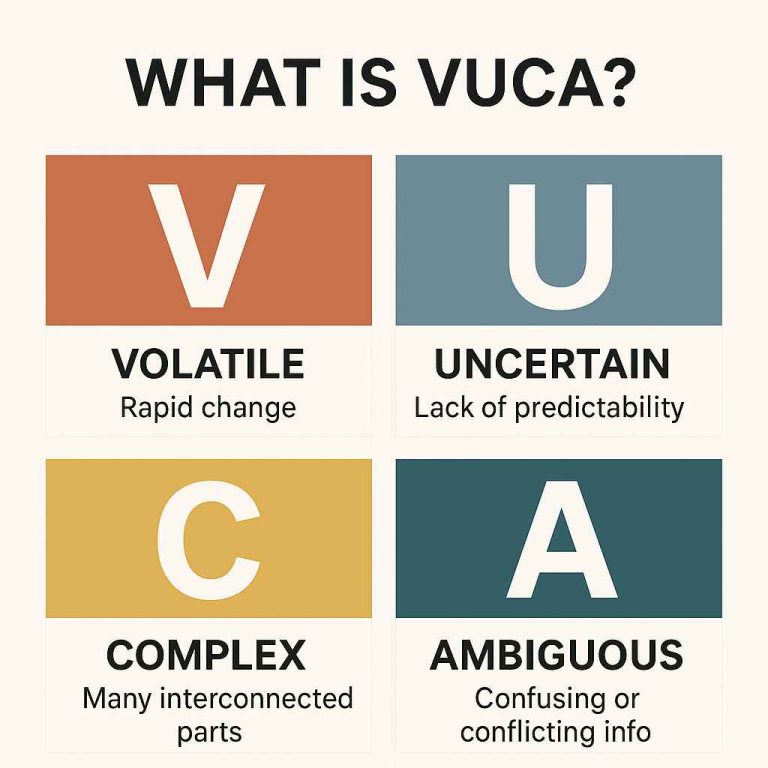
These four forces challenge the very foundations of traditional governance, policy design, and institutional planning.
This reality isn’t theoretical—it’s already unfolding in institutions around the world.
Around the world—from Nordic digital democracies to African smart city experiments—governments are struggling to evolve. But this need for transformation is especially urgent in the Arab world, where public institutions must navigate not only global technological shifts but also unique cultural, bureaucratic, and political complexities.
Drawing on real-world experience from Egypt, Oman, the UAE, Saudi Arabia, Qatar, and Bahrain, it’s evident that navigating these layered systems requires a new way of thinking: systems thinking.
From Control to Coordination: The Collapse of the Old Paradigm
For much of the 20th century, public institutions operated on a simple premise: the world is orderly and predictable. This mindset led to:
- Hierarchical structures with top-down control
- Standardized procedures designed for consistency
- Forecast-based planning assuming future conditions mirror the past
While effective in stable times, this model fails in today’s volatile, interconnected world. Rigid systems struggle to adapt. Oversimplified KPIs can distort behavior. And command-and-control leadership often stifles innovation.
| Old Paradigm | Adaptive Institutional Thinking |
|---|---|
| Control-based planning | Context-aware coordination |
| Hierarchical command structures | Distributed, networked governance |
| Standardization and uniformity | Flexibility and contextual adaptation |
| Focus on outputs and KPIs | Focus on outcomes, learning, and feedback loops |
| Prediction and long-term forecasting | Iteration and safe-to-learn experiments |
| Silos and linear project management | Cross-sector collaboration and systemic coherence |
| Blame and risk aversion | Transparency, shared learning, and adaptation |
| Reactive crisis response | Proactive sensing and anticipatory design |
| Top-down reform enforcement | Emergent change through empowered stakeholders |
| Short-term wins | Sustainable transformation with long time horizons |
Complexity Demands a New Leadership Mindset
Today’s reality is dynamic, nonlinear, and deeply interdependent. The leadership model must change.
Instead of providing all the answers, modern leaders must:
- Create conditions that enable emergence
- Foster collaboration across silos and sectors
- Navigate uncertainty, not eliminate it
Traits of Complexity Leadership
Leading in complex systems requires more than authority—it requires adaptive capacity and a mindset of continuous learning. Leaders who thrive in these environments often embody traits such as:
- 🔀 Adaptive – Responsive to changing conditions
- 🌐 Networked – Connected across stakeholders and systems
- 🤝 Collaborative – Builds bridges across silos
- 📘 Learning-oriented – Treats failure as feedback
- 👐 Enabling, not controlling – Creates space for emergence and innovation
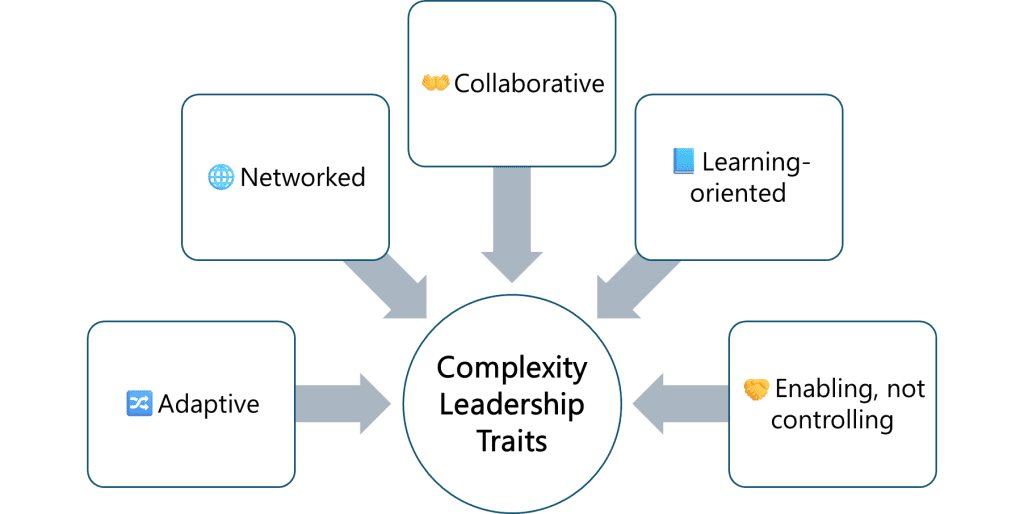
This new approach is already visible in open-source communities, gig economy networks, and even protest movements—systems that thrive through distributed coordination.
To lead effectively in such environments, leaders need more than courage—they need a practical lens for understanding and influencing complex systems. That’s where systems thinking comes in.
What Systems Thinking Offers Institutions
Systems thinking views institutions not as machines to be controlled, but as living, adaptive systems. It helps leaders:
- Map feedback loops that cause policy resistance
- Recognize time delays between action and results
- Identify leverage points where small changes create big shifts
- Design adaptive strategies that evolve over time
This lens equips public servants to respond to complexity at its root—shifting from firefighting symptoms to redesigning systems.
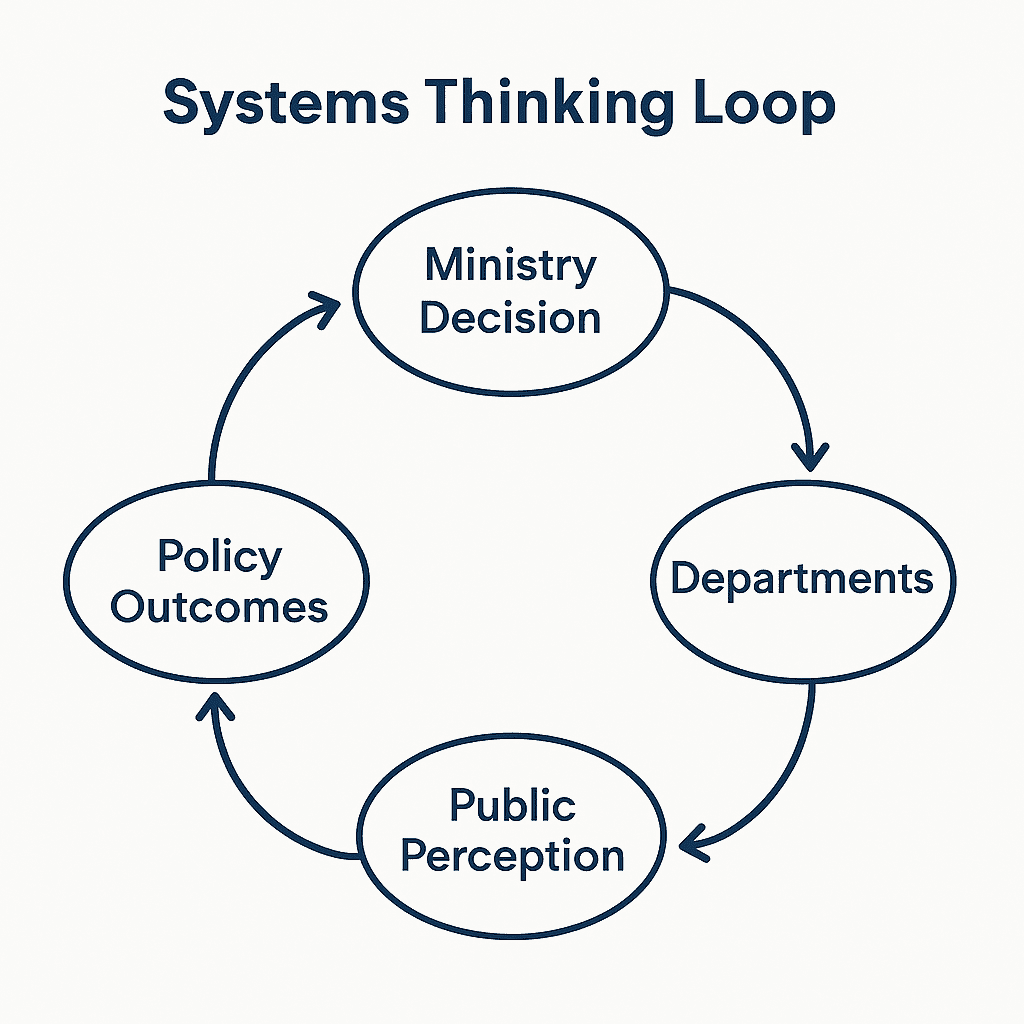
Dive deeper into this perspective by reading “The Living Dance of Systems.“
A Practical Framework: Institutional Complexity Navigation Toolkit
To apply systems thinking in public sector transformation, we propose a five-step framework:
- Sense Complexity
Use tools like stakeholder maps or causal loop diagrams to make hidden dynamics visible. - Frame Systemic Tensions
Surface the real dilemmas (e.g., innovation vs. stability, centralization vs. decentralization). - Test Adaptive Hypotheses
Pilot small-scale interventions and evolve based on real feedback. - Learn in Public
Share progress transparently—even the failures—to foster institutional learning. - Embed Learning Loops
Move beyond end-of-project evaluations to continuous, real-time learning.
👉 Your journey into embracing complexity is about to gain a powerful new companion. The full Institutional Complexity Navigation Toolkit, complete with all templates and practical guides, is nearing release. Ensure you’re among the first to gain access and receive exclusive updates on its evolution by subscribing to our newsletter today.
Real-World Reflections from the Arab Region
🇪🇬 Egypt: Fragmented Reform Amid Digital Push
Pros:
- Strong digital transformation agenda (e.g., unified gov portal)
- Frequent policy innovation and international partnerships
Cons:
- Deep institutional silos and poor coordination
- Top-down reforms with limited citizen input
- Surface-level digitization without systemic culture change
🇴🇲 Oman: Deliberate, Culturally-Aligned Progress
Pros:
- Vision 2040 encourages cross-sectoral collaboration
- Bayan logistics platform integrates 40+ agencies
- Innovation Lab applies systems mapping in policy
Cons:
- Pilots remain isolated and under-leveraged
- Slow pace risks missed reform windows
- Lack of shared KPIs reduces coherence
🇦🇪 UAE: Innovation Hub with Top-Down Risks
Pros:
- Agile, foresight-driven governance (e.g., MBRCGI, 2071)
- Emphasis on experimentation and safe failure
- Strong digital infrastructure and federal-local collaboration
Cons:
- Innovation often dependent on top leadership
- Behind the innovation façade, some silos persist
- Civil participation remains limited
🇸🇦 Saudi Arabia: Ambitious Yet Overloaded
Pros:
- Vision 2030 anchors deep institutional transformation
- Leading digital services like Absher and Tawakkalna
- Signs of systemic capacity building emerging
Cons:
- Early rigid planning slowed progress
- Coordination overload across 100s of entities
- Feedback loops weak, participation minimal
🇶🇦 Qatar: High-Tech Execution, Low Pluralism
Pros:
- Highly integrated platforms (Hukoomi, Metrash2)
- Centralized agility allows fast reform
- Strategic alignment with sustainability goals
Cons:
- Elite-driven innovation, limited grassroots input
- Low diversity in policy feedback
- Heavy dependence on foreign expertise
🇧🇭 Bahrain: Lean Innovation Under Constraint
Pros:
- Early digital adoption, strong e-Gov portal
- Cost-effective reforms due to budget discipline
- Rising youth involvement in governance
Cons:
- Financial and political fragility slow reform scale
- Institutional silos persist
- Systems thinking practices remain immature
Patterns Across the Region
Shared Strengths:
- Ambitious national visions (e.g., Vision 2030, Vision 2040)
- Digital transformation is a priority across the board
- Political will at the leadership level is high
Shared Weaknesses:
- Reforms often top-down and siloed
- Learning from failure is rare and unsafe
- Pilots are not institutionalized or scaled
From Mechanical to Ecological Thinking
The stories above reveal a shared lesson: complexity cannot be solved by control. Institutions are not machines. They are ecosystems—filled with humans, history, incentives, and emergence.
The future cannot be engineered through control—it must be cultivated.
This calls for a shift from mechanical to ecological thinking—one that embraces uncertainty, diversity, and evolution.
Systems thinking doesn’t offer certainty—it offers clarity. It helps leaders see:
- That unintended consequences are signals, not setbacks
- That resistance often contains insight
- That slow change is often deep and lasting
Practical Entry Points for Leaders
- Run a Systems Audit: Identify feedback traps and silos in your institution
- Use Influence Diagrams: Facilitate dialogue across stakeholders
- Design Safe-to-Learn Pilots: Embed feedback loops and learning routines
- Reflect on Past Reforms: Examine delays, loops, and leverage
- Foster Institutional Learning: Normalize learning in public
Explore our series Systems Thinking Unveiled or contact us for a tailored session.
The Journey from Control to Complexity
The transformation from legacy governance models to adaptive, systems-aware institutions doesn’t happen overnight. It’s a journey—from control and efficiency, through experimentation, toward a future-ready mindset.
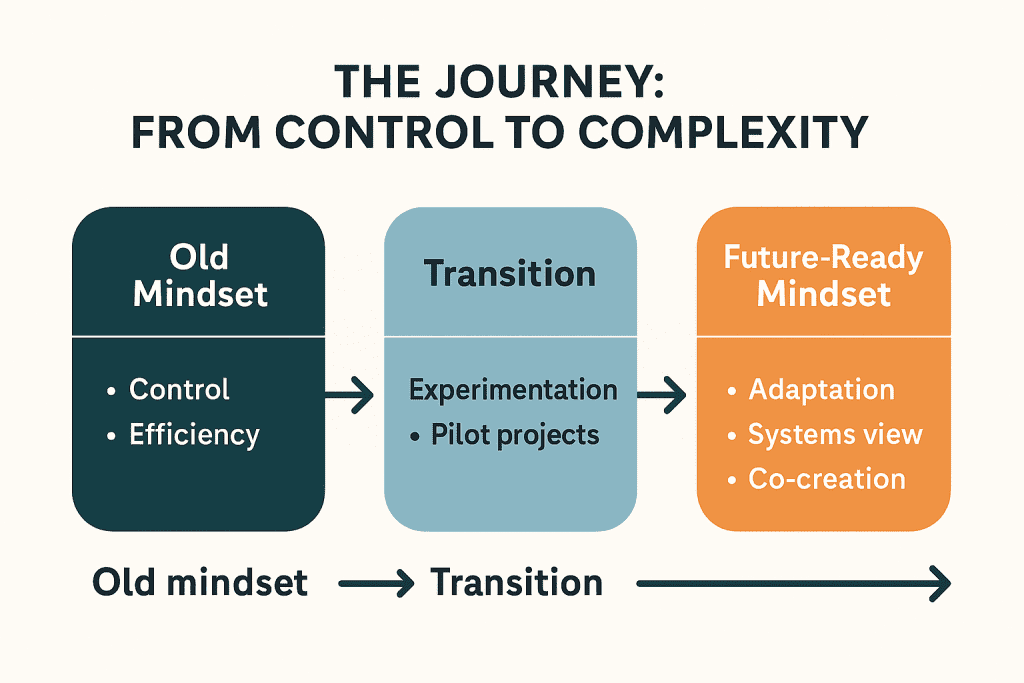
This progression requires intention, learning, and commitment. But it also unlocks the potential for deeper resilience, innovation, and impact.
Final Thought: Building the Future by Thinking Differently
The future belongs not to those who predict it—but to those who shape it.
By embracing complexity:
- We shift from prediction to possibility
- From planning to experimentation
- From control to collaboration
“The only way to make sense out of change is to plunge into it, move with it, and join the dance.”
— Alan Watts


